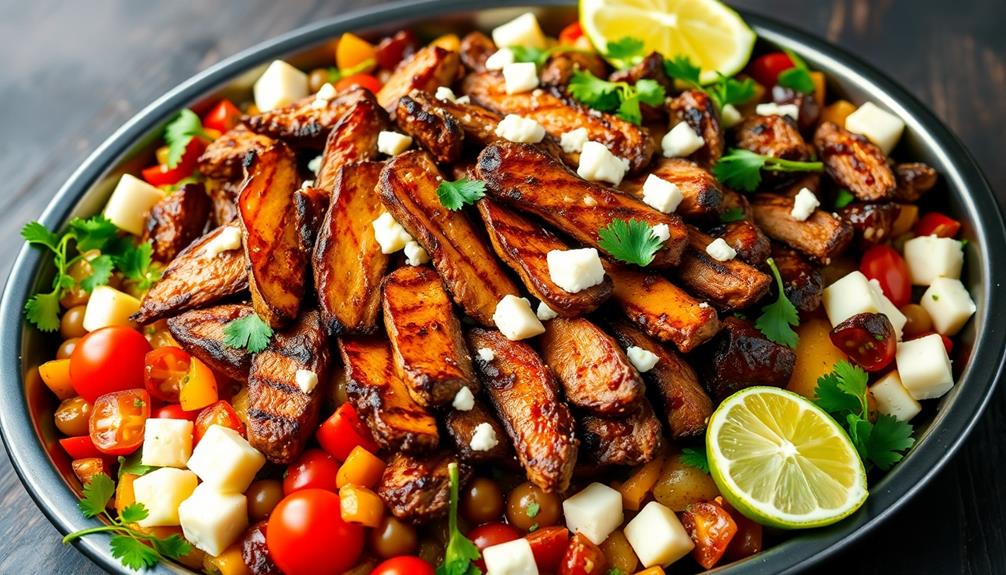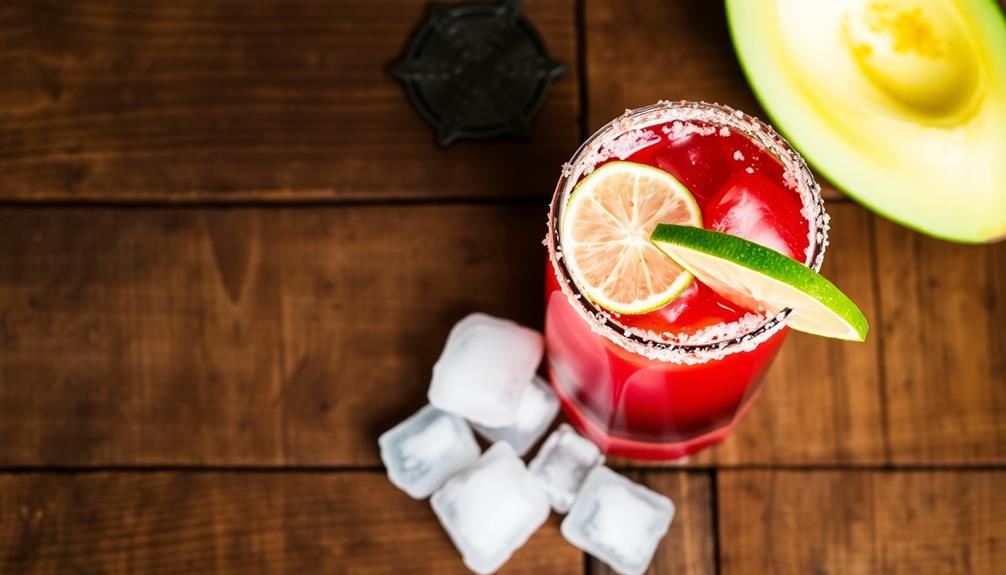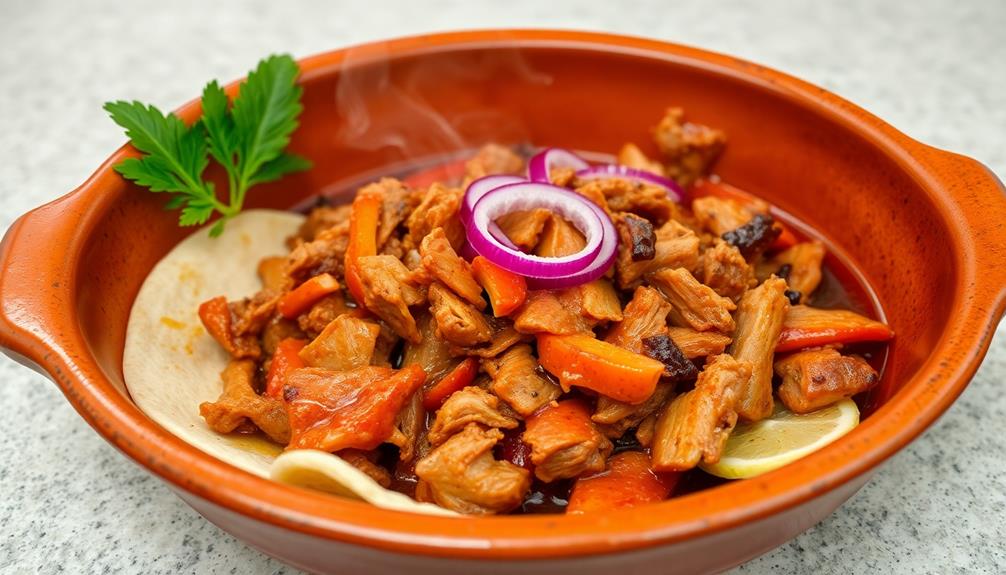Alambre is a mouthwatering Mexican street food that'll transport your taste buds straight to the bustling markets of Jalisco. You'll find tender grilled steak, crispy bacon, melty cheese, and vibrant veggies all wrapped up in warm tortillas – what a flavor explosion! The name "alambre" means "wire" in Spanish, referring to the skewered cooking method used by Mexican cowboys. This hearty dish is a true reflection of Mexico's rich culinary heritage. From family gatherings to lively celebrations, Alambre continues to delight food lovers across the country. If you're curious to learn more about this savory sensation, keep reading!
Key Takeaways
- Alambre is a traditional Mexican dish that originated from the state of Jalisco, featuring grilled steak, bacon, vegetables, and cheese skewered on a wire.
- The dish is a reflection of the rich culinary heritage of Mexico, showcasing regional ingredients and cooking techniques passed down through generations.
- Alambre is a popular street food and is often prepared during family gatherings and celebrations, connecting people through shared recipes and experiences.
- The key components of Alambre include flank steak, bacon, bell peppers, onions, cheese, and tortillas, which are grilled to achieve tenderness and crispiness.
- Alambre is a versatile dish that can be customized with various toppings and sides, catering to different dietary preferences and taste preferences.
History
The origins of alambre can be traced back to Mexican cuisine, where this savory dish has long been a staple. Alambre, which means "wire" in Spanish, gets its name from the way the ingredients are skewered and grilled, just like a shish kebab. This tasty dish typically features juicy steak, crisp bacon, melted cheese, and an array of vibrant vegetables like bell peppers and onions.
The history of alambre is closely tied to the rich culinary traditions of Mexico. As Mexican cowboys, known as vaqueros, would spend long days working on the ranch, they needed a filling and portable meal. Alambre fit the bill perfectly, as it could be easily prepared over an open fire and enjoyed on the go.
Over time, this hearty dish became a beloved part of Mexican culture, finding its way into homes, street vendors, and restaurants across the country.
Today, alambre continues to delight taste buds with its mouthwatering blend of smoky, savory, and tangy flavors. Whether you're a longtime fan or trying it for the first time, this classic Mexican dish is sure to leave you craving more.
Recipe
Alambre is a popular Mexican street food dish that originated in Jalisco. It's a tasty combination of grilled steak, bacon, bell peppers, onions, and melted cheese, all served on a warm tortilla.
The key to a delicious Alambre is to use high-quality ingredients and to grill the components to perfection. The grilled steak should be tender and flavorful, the bacon crispy, and the vegetables slightly charred for maximum flavor.
Ingredients:
- 1 lb flank steak, cut into thin strips
- 8 slices of bacon, chopped
- 1 green bell pepper, sliced
- 1 red bell pepper, sliced
- 1 onion, sliced
- 1 cup shredded Oaxaca or Monterey Jack cheese
- 8 flour tortillas
Cooking Instructions:
In a large skillet or on a grill, cook the bacon until crispy. Remove the bacon and set aside, reserving the bacon grease in the pan.
Add the steak strips to the hot pan and cook until browned on all sides, about 5 minutes. Add the bell peppers and onions to the pan and continue cooking until the vegetables are tender and the steak is cooked through, about 10 minutes more.
Sprinkle the shredded cheese over the top and let it melt, about 2-3 minutes. Serve the Alambre mixture on the warm tortillas, topped with the reserved crispy bacon.
Tip: For an extra flavorful Alambre, you can marinate the steak in a mixture of lime juice, garlic, and spices before cooking.
Additionally, you can serve the Alambre with diced avocado, salsa, and crema for a delicious finishing touch.
Cooking Steps
Slice up those onions and bell peppers – they'll add a tasty crunch to your alambre!
Next, cook the meat until it's nice and browned.
Now, sprinkle on the gooey, melty cheese and top it off with some diced tomatoes.
Serve it all up with warm tortillas or fluffy rice for a delicious meal.
Step 1. Slice Onions and Bell Peppers

Start by slicing the onions and bell peppers into thin strips. Take your time and be careful – you don't want any tears from the onions! Slice them evenly so they'll cook at the same rate.
As for the bell peppers, hold them by the stem and slice downward to get long, thin strips. You want them to be about the same size as the onion strips. Remember to keep your furry friends in mind; while you're prepping, avoid any toxic foods for dogs like grapes that might be within reach.
Now, grab a large skillet and heat it over medium heat. Add a splash of oil and let it get nice and hot. Toss in the sliced onions and peppers. Stir them around so they don't stick to the pan.
The onions should start to turn golden brown and the peppers will become soft and tender. Keep stirring and cooking until everything is perfectly cooked, about 5-7 minutes. You'll know they're ready when the kitchen is filled with the delicious aroma!
Get ready for the next step in making your tasty alambre.
Step 2. Cook the Meat

With the onions and peppers sizzling away, it's time to add the meat! First, grab your favorite type of beef – maybe some tender, juicy steak or spicy chorizo sausage. Cut it into bite-sized pieces, so it cooks evenly.
Toss the meat into the hot pan and let it sizzle and brown, stirring occasionally. The savory scent will start to fill your kitchen, making your mouth water. As the meat cooks, it'll release all those delicious juices, mixing with the caramelized onions and peppers.
Keep an eye on it, making sure not to overcook – you want the meat to be nice and tender. Once it's cooked through, it's ready to be piled high on your tortilla, along with the rest of the tasty toppings.
Get ready for a flavor explosion in every bite!
Step 3. Add the Cheese
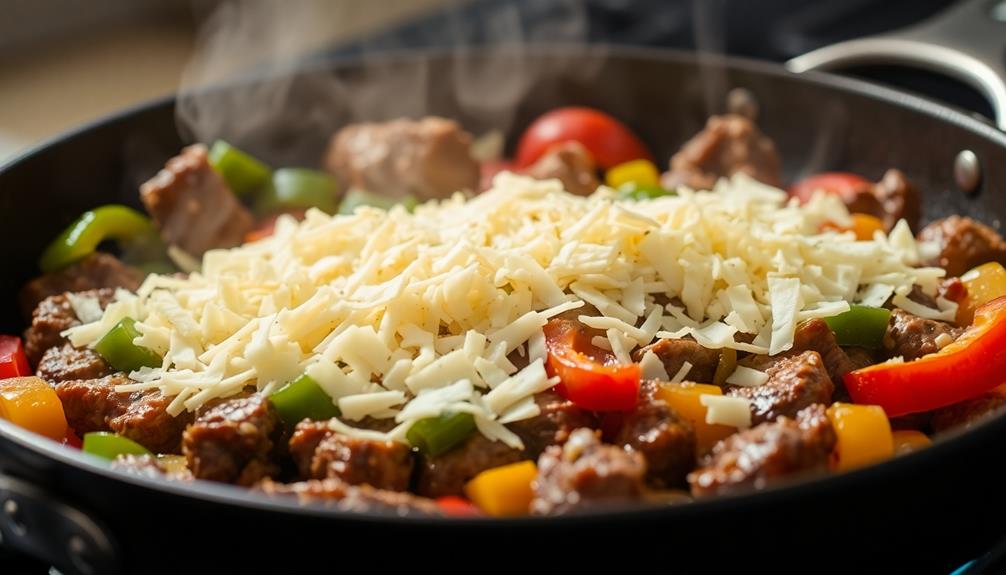
Next, add a generous layer of shredded cheese over the sizzling meat and veggies. The aroma of melting cheese will make your mouth water!
Sprinkle it evenly, making sure every bite will be cheesy and delicious. As the cheese starts to melt, you'll see it bubbling and turning a lovely golden brown. Mmm, the gooey, melty goodness is the perfect complement to the tender beef and crunchy peppers.
Don't be shy – pile on that cheese! The more the better, so every forkful is oozing with cheesy flavor. You can even try different types of cheese, like sharp cheddar or creamy Oaxaca, to mix up the taste.
Just let the cheese melt completely before moving on to the next step. Yum, this is really coming together into one tasty, cheesy masterpiece!
Step 4. Add Diced Tomatoes
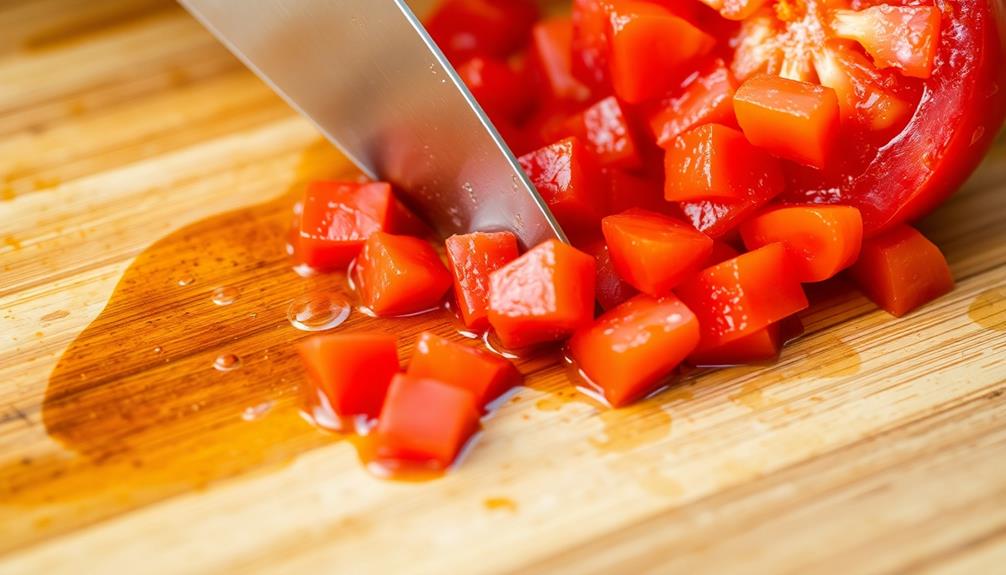
After the cheesy goodness has been added, go ahead and toss in some diced tomatoes.
These little cubes of juicy, vibrant red will add a burst of flavor and a pop of color to your dish. Imagine the sizzling sound as the tomatoes hit the pan, releasing their fragrant aroma.
Watch them soften and meld with the other ingredients, creating a harmonious blend of textures and tastes.
Be generous with the tomatoes – you want enough to complement the other components without overpowering them.
Sprinkle them in, stirring gently to distribute them evenly. The tomatoes will lend a refreshing tanginess that balances out the richness of the cheese. Plus, their juicy bite will add a lovely contrast to the other elements.
Now that the tomatoes are incorporated, take a moment to inhale the mouthwatering scent wafting through the air.
Your Alambre is coming together beautifully, and you're one step closer to enjoying a delicious, flavor-packed meal.
Step 5. Serve With Tortillas or Rice
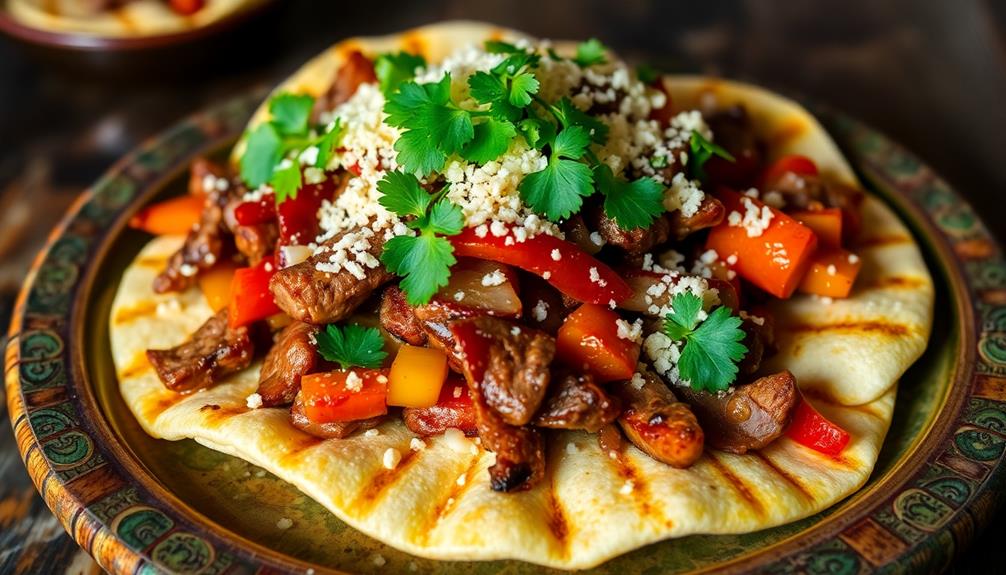
To perfectly complement your delectable Alambre, you can either serve it alongside warm, soft tortillas or fluffy, fragrant rice.
Tortillas make for a delightful pairing, allowing you to scoop up all the flavors and textures of the Alambre in every bite. Their supple, grilled goodness will soak up the juices and seasonings, creating a harmonious blend.
Alternatively, rice is an equally excellent choice, providing a bed of comforting starch to balance the bold flavors. The rice's light, fluffy texture will contrast beautifully with the hearty Alambre, while also soaking up all the rich, savory goodness.
Whether you choose tortillas or rice, the resulting dish will be a true celebration of taste and texture.
Final Thoughts
As we conclude our exploration of the captivating dish known as Alambre, it's clear that this vibrant Mexican street food offers a delightful fusion of flavors and textures.
From the sizzling beef and crisp bacon to the tender veggies and tangy cheese, every bite is a celebration of the senses. You'll be impressed by how the ingredients come together in perfect harmony, creating a mouthwatering experience that's sure to leave you craving more.
Beyond its delicious taste, Alambre also holds cultural significance, reflecting the rich culinary heritage of Mexico.
By preparing and sharing this dish, you can connect with the traditions and flavors that have been passed down through generations.
Whether you enjoy it with warm tortillas or fluffy rice, Alambre is a versatile and satisfying meal that's perfect for any occasion.
Frequently Asked Questions
What Are the Origins of the Name "Alambre"?
You're curious about the origins of the name "alambre," aren't you? The word derives from the Spanish term for "wire," reflecting the dish's signature grilled meat and vegetable skewers. It's a flavorful Mexican specialty with roots in traditional cooking techniques.
How Can I Customize the Ingredients to My Taste?
You can customize the ingredients to your taste by adding your favorite meats, cheeses, and vegetables. Don't be afraid to experiment and make the dish your own!
Is It Possible to Make a Vegetarian/Vegan Version of Alambre?
Absolutely! You can create a delicious vegetarian or vegan version of this dish. Simply substitute the meat with grilled or sautéed vegetables, tofu, or plant-based protein. Customize the seasonings and toppings to your liking for a flavorful meatless meal.
How Long Does Alambre Typically Take to Prepare?
Typically, preparing an alambre dish takes about an hour and a half to two hours, depending on the ingredients and cooking method used. It involves sautéing and grilling various elements, which can take time to assemble and cook thoroughly.
Can I Make Alambre in Advance and Reheat It Later?
You can absolutely make the dish in advance and reheat it later. The key is to ensure it's stored properly and reheated gently to maintain the flavors and textures. With some planning, you can have this tasty meal ready when you need it.
